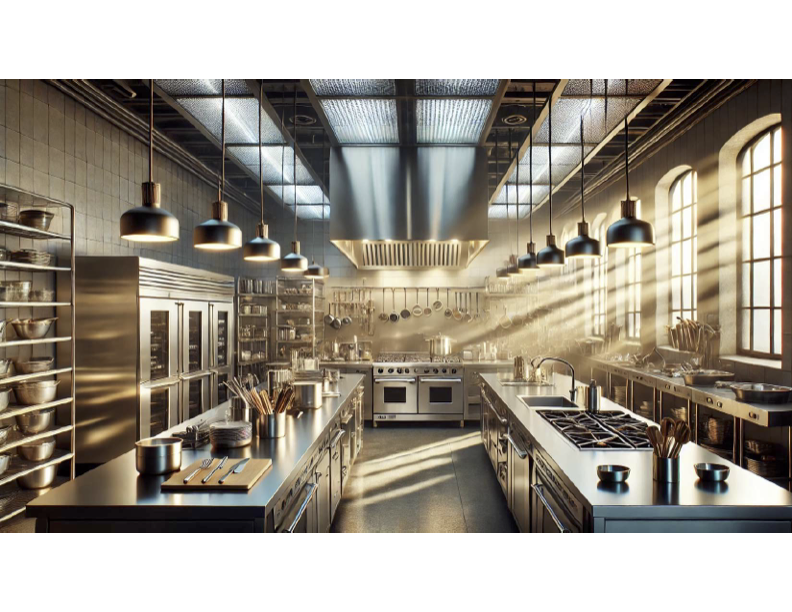Lighting is a critical component of a commercial kitchen's functionality and safety. When integrated with your ventilation system, the right lighting ensures optimal visibility for kitchen staff, promotes safety, and enhances efficiency. Here’s a guide to help you choose the best lighting for your commercial kitchen ventilation system.
1. Understand the Role of Lighting in Commercial Kitchens
- Safety and Efficiency: Proper lighting minimizes the risk of accidents by ensuring that every corner of the kitchen is well-illuminated.
- Compliance with Regulations: Many local health and safety codes specify minimum lighting requirements for commercial kitchens, particularly over cooking and food preparation areas.
- Integration with Ventilation: Lighting in the ventilation system provides focused illumination directly over cooking surfaces, ensuring precise preparation and cooking.
2. Key Considerations for Lighting Selection
a. Brightness and Lumens
- Opt for high-lumen output lights to ensure the workspace is bright enough for detailed tasks.
- Aim for a minimum of 50 foot-candles (540 lux) of light over food preparation areas.
b. Heat and Moisture Resistance
- Kitchens are hot and humid environments, so lighting should withstand high temperatures and moisture.
- Look for fixtures with high IP (Ingress Protection) ratings to guard against water and grease infiltration.
c. Energy Efficiency
- LED lights are ideal due to their energy efficiency, longevity, and minimal heat output.
- Consider motion-sensor or dimmable LEDs to reduce energy consumption during off-peak hours.
d. Color Rendering Index (CRI)
- Choose lights with a CRI of 80 or above to ensure accurate color representation of food, which is essential for quality and presentation.
e. Easy Maintenance
- Fixtures should be easy to clean and maintain, as grease and grime can quickly accumulate in a commercial kitchen.
3. Types of Lighting for Ventilation Systems
a. LED Integrated Ventilation Hood Lighting
- Many modern commercial kitchen ventilation systems come with built-in LED lights.
- These lights are durable, energy-efficient, and designed to handle the rigors of a kitchen environment.
b. Recessed or Surface-Mounted Lighting
- For ventilation systems without built-in lights, recessed or surface-mounted fixtures can be installed.
- Ensure these lights are positioned for even distribution and minimal shadowing.
c. Explosion-Proof Lights
- In kitchens where there’s a risk of flammable grease or vapors, explosion-proof fixtures may be required.
4. Regulatory Compliance and Standards
- Check local building codes and health department guidelines for commercial kitchen lighting standards.
- Ensure lighting meets ANSI/NSF International standards for commercial food equipment.
- Consult with your ventilation system supplier to ensure that lighting installations do not interfere with the system's airflow and exhaust functions.
5. Installation and Maintenance Tips
- Position lights strategically to illuminate cooking and prep areas without creating glare or shadows.
- Use shatterproof bulbs or protective covers to prevent glass contamination in food areas.
- Schedule regular cleaning and inspection to maintain lighting performance and safety.
6. Benefits of Optimal Lighting in Ventilation Systems
- Improved Safety: Reduces the risk of slips, cuts, and burns by ensuring visibility.
- Enhanced Productivity: Staff can work more efficiently with adequate lighting.
- Energy Savings: Modern lighting options reduce energy costs and have lower environmental impacts.
- Better Food Quality: Proper lighting allows for accurate inspection of food quality and presentation.
Conclusion
Choosing the right lighting for your commercial kitchen ventilation system involves balancing brightness, durability, energy efficiency, and compliance with safety standards. By investing in high-quality, purpose-built lighting solutions, you can create a safer, more productive kitchen environment that meets both operational needs and regulatory requirements. Always consult with industry professionals to select the best lighting options for your specific ventilation setup.

